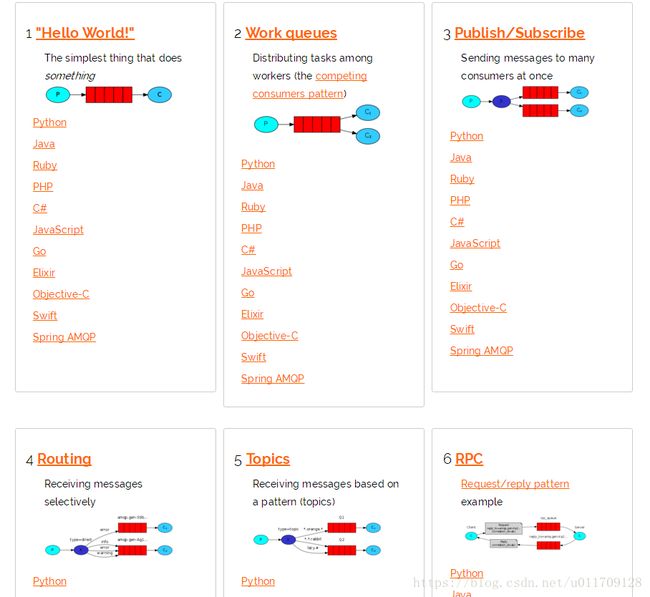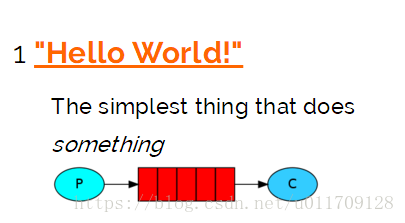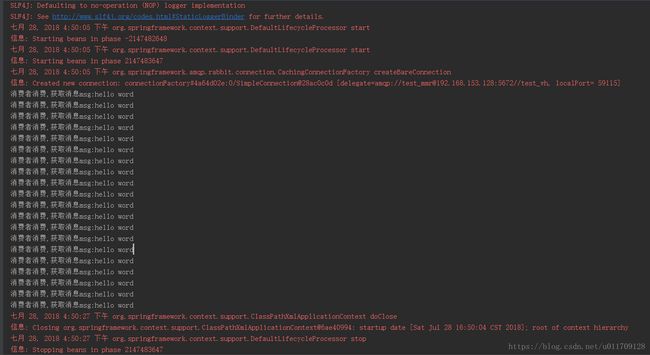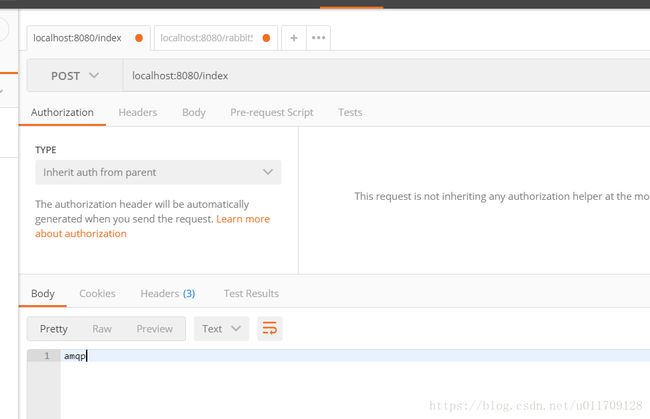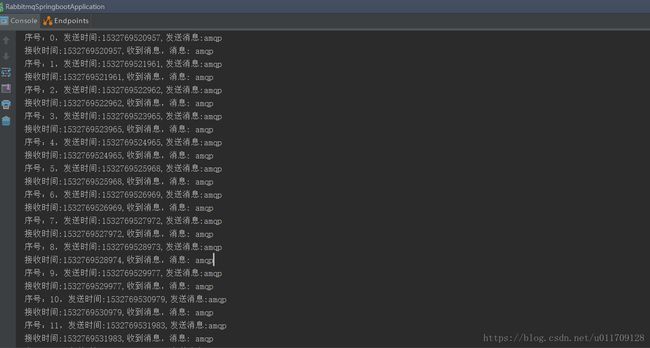RabbitMQ工作队列模式简介,以及简单队列模式(一)
RabbitMQ工作队列模式简介,以及简单队列模式(一)
本篇文章主要讲解RabbitMQ的简单使用、以及集成srping后的简单使用:
- 简单引入RabbitMQ的客户端使用
- 简单集成spring配置文件使用
- 简单集成springboot使用
目录
用 [TOC]来生成目录:
- RabbitMQ工作队列模式简介,以及简单队列模式(一)
-
- 目录
- 后续会逐步完善各种使用姿势、以及对使用的详解
- 下列的使用,都是围绕简单队列实现的,我们每一章,都讲一种工作模式
- 并且,后续的章节,都是以下列的demo例子的基础上,进行使用。
- 1、简单引入RabbitMQ的客户端使用
-
-
- 首先创建maven工程,pom文件配置如下:
- 创建一个获取RabbitMQ连接工具类:
- 创建一个消息生产者类:
- 创建一个消息消费者类:
- 消息发送:
- RabbitMQ管控台查看一下:
- 执行消费操作:
- 再次查看RabbitMQ管控台:
-
-
- 2、spring集成RabbitMQ
-
-
- 构建maven项目,pom文件如下:
- 在resource目录下,创建context.xml,spring配置如下:
- 在resource目录下,创建rabbitmq.xml,设置rabbitmq的配置信息,如下:
- 定义消费者
- 定义启动类,以及消息生产
- 下面是运行情况:
-
- 3、springboot集成rabbitMQ
-
- 构建springboot项目,pom文件如下:
- 创建springboot入口程序
- 在resource目录下,创建application.yml,内容如下:
- 创建消费者
- 创建一个Controller类,进行发送消息至RabbitMQ
- 执行的时候,我们直接运行入口程序即可,通过网页post请求进行访问。
-
- 小结
-
-
后续会逐步完善各种使用姿势、以及对使用的详解
在使用之前,先介绍一下rabbitMQ所拥有的工作队列模式
rabbitMQ官网教程地址:http://www.rabbitmq.com/getstarted.html
在官网教程中,描述了六类工作队列模式:
1、简单队列模式:最简单的工作队列,其中一个消息生产者,一个消息消费者,一个队列。也称为点对点模式
2、竞争消费者模式:一个消息生产者,一个交换器,一个消息队列,多个消费者。同样也称为点对点模式
3、发布/订阅模式:无选择接收消息,一个消息生产者,一个交换器,多个消息队列,多个消费者。称为发布/订阅模式
4、Routing模式:在发布/订阅模式的基础上,有选择的接收消息,也就是通过routing进行匹配条件是否满足接收消息。
5、主题模式:同样是在发布/订阅模式的基础上,根据主题匹配进行筛选是否接收消息,比第四类更灵活。
6、RPC模式:与上面其他5种所不同之处,类模式是拥有请求/回复的。也就是有响应的,上面5种都没有。
下列的使用,都是围绕简单队列实现的,我们每一章,都讲一种工作模式
并且,后续的章节,都是以下列的demo例子的基础上,进行使用。
1、简单引入RabbitMQ的客户端使用
首先创建maven工程,pom文件配置如下:
<project xmlns="http://maven.apache.org/POM/4.0.0"
xmlns:xsi="http://www.w3.org/2001/XMLSchema-instance"
xsi:schemaLocation="http://maven.apache.org/POM/4.0.0 http://maven.apache.org/xsd/maven-4.0.0.xsd">
<parent>
<artifactId>eduartifactId>
<groupId>cn.edumqgroupId>
<version>1.0-SNAPSHOTversion>
parent>
<modelVersion>4.0.0modelVersion>
<artifactId>rabbitmqartifactId>
<dependencies>
<dependency>
<groupId>com.rabbitmqgroupId>
<artifactId>amqp-clientartifactId>
<version>5.3.0version>
dependency>
dependencies>
project>创建一个获取RabbitMQ连接工具类:
package com.edu.rabbitmq;
import com.rabbitmq.client.Connection;
import com.rabbitmq.client.ConnectionFactory;
import java.io.IOException;
import java.util.concurrent.TimeoutException;
/**
* @author : alex
* @version :1.0.0
* @Date : create by 2018/7/19 22:01
* @description :获取连接
* @note 注意事项
*/
public class ConnectionUtils {
//获取接连
public static Connection getConnection() throws IOException, TimeoutException {
ConnectionFactory factory = new ConnectionFactory();
//设置连接MQ的IP地址
factory.setHost("192.168.153.128");
//设置连接端口号
factory.setPort(5672);
//设置要接连MQ的库(域)
factory.setVirtualHost("/test_vh");
//连接帐号
factory.setUsername("root");
//连接密码
factory.setPassword("123456");
return factory.newConnection();
}
}
创建一个消息生产者类:
package com.edu.handler;
import com.edu.rabbitmq.ConnectionUtils;
import com.rabbitmq.client.Channel;
import com.rabbitmq.client.Connection;
import java.io.IOException;
import java.util.concurrent.TimeoutException;
/**
* @author : alex
* @version :1.0.0
* @Date : create by 2018/7/19 22:16
* @description :消息生产者
* @note 注意事项
*/
public class Send {
//队列名称
public static String QUEUE_NAME = "test_simple_queue";
public static void main(String[] args) throws IOException, TimeoutException {
//获取连接
Connection connection = ConnectionUtils.getConnection();
//从连接中获取一个通道
Channel channel = connection.createChannel();
//创建消息声明
channel.queueDeclare(QUEUE_NAME,false,false,false,null);
//自定义消息
String msg = "hello word";
//发布消息
channel.basicPublish("",QUEUE_NAME,null,msg.getBytes());
System.out.println("-->send " + msg);
channel.close();//关闭通道
connection.close();//关闭连接
}
}
创建一个消息消费者类:
package com.edu.handler;
import com.edu.rabbitmq.ConnectionUtils;
import com.rabbitmq.client.*;
import java.io.IOException;
import java.util.concurrent.TimeoutException;
/**
* @author : alex
* @version :1.0.0
* @Date : create by 2018/7/19 22:16
* @description :消息消费者
* @note 注意事项
*/
public class Customer {
//队列名称
public static String QUEUE_NAME = "test_simple_queue";
public static void main(String[] args) throws IOException, TimeoutException {
//创建连接
Connection connection = ConnectionUtils.getConnection();
//获取通道
Channel channel = connection.createChannel();
//创建消息声明
channel.queueDeclare(QUEUE_NAME,false,false,false,null);
//定义消费者
DefaultConsumer consumer = new DefaultConsumer(channel) {
@Override
public void handleDelivery(String consumerTag, Envelope envelope, AMQP.BasicProperties properties, byte[] body)
throws IOException {
//获取并转成String
String message = new String(body, "UTF-8");
System.out.println("-->收到消息,msg:"+message);
}
};
//监听队列
channel.basicConsume(QUEUE_NAME, true, consumer);
}
}
最简单的使用姿势就完成了,一共三个类,连接类,消息生产者,消息消费者。让我们来运行一下
消息发送:
RabbitMQ管控台查看一下:
执行消费操作:
再次查看RabbitMQ管控台:
2、spring集成RabbitMQ
构建maven项目,pom文件如下:
<project xmlns="http://maven.apache.org/POM/4.0.0"
xmlns:xsi="http://www.w3.org/2001/XMLSchema-instance"
xsi:schemaLocation="http://maven.apache.org/POM/4.0.0 http://maven.apache.org/xsd/maven-4.0.0.xsd">
<parent>
<artifactId>eduartifactId>
<groupId>cn.edumqgroupId>
<version>1.0-SNAPSHOTversion>
parent>
<modelVersion>4.0.0modelVersion>
<artifactId>rabbitmq-springartifactId>
<dependencies>
<dependency>
<groupId>com.rabbitmqgroupId>
<artifactId>amqp-clientartifactId>
<version>4.0.0version>
dependency>
<dependency>
<groupId>org.springframework.amqpgroupId>
<artifactId>spring-rabbitartifactId>
<version>1.7.3.RELEASEversion>
dependency>
<dependency>
<groupId>org.springframeworkgroupId>
<artifactId>spring-coreartifactId>
<version>5.0.7.RELEASEversion>
dependency>
<dependency>
<groupId>org.springframeworkgroupId>
<artifactId>spring-beansartifactId>
<version>5.0.7.RELEASEversion>
dependency>
<dependency>
<groupId>org.springframeworkgroupId>
<artifactId>spring-contextartifactId>
<version>5.0.7.RELEASEversion>
dependency>
dependencies>
project>在resource目录下,创建context.xml,spring配置如下:
<beans xmlns="http://www.springframework.org/schema/beans"
xmlns:xsi="http://www.w3.org/2001/XMLSchema-instance"
xsi:schemaLocation="
http://www.springframework.org/schema/beans
http://www.springframework.org/schema/beans/spring-beans.xsd
http://www.springframework.org/schema/beans
http://www.springframework.org/schema/beans/spring-beans-4.0.xsd">
<import resource="classpath:rabbitmq.xml" />
beans>在resource目录下,创建rabbitmq.xml,设置rabbitmq的配置信息,如下:
在这里啰嗦两句,之前通过分析spring源码可知,spring验证xml的方式就是xsd和dtd。
那么我们使用xml配置文件进行配置的时候,需要有spring-rabbit-1.7.xsd
同时,我们也可以进入spring-rabbit-1.7.xsd这个文件内部去看各种使用的姿势,这里就不全部讲解了。
<beans xmlns="http://www.springframework.org/schema/beans"
xmlns:xsi="http://www.w3.org/2001/XMLSchema-instance"
xmlns:rabbit="http://www.springframework.org/schema/rabbit"
xsi:schemaLocation="
http://www.springframework.org/schema/beans
http://www.springframework.org/schema/beans/spring-beans.xsd
http://www.springframework.org/schema/rabbit
http://www.springframework.org/schema/rabbit/spring-rabbit-1.7.xsd
http://www.springframework.org/schema/beans
http://www.springframework.org/schema/beans/spring-beans-4.0.xsd">
<rabbit:connection-factory id="connectionFactory" virtual-host="/test_vh" username="test_mmr"
password="123456" host="192.168.153.128" port="5672"/>
<rabbit:template id="amqpTemplate" connection-factory="connectionFactory" />
<rabbit:admin connection-factory="connectionFactory" />
<rabbit:queue name="test_mmr" auto-declare="true" />
<rabbit:listener-container connection-factory="connectionFactory">
<rabbit:listener ref="myCustomer" method="listen" queue-names="test_mmr"/>
rabbit:listener-container>
<bean id="myCustomer" class="com.rabbitmq.handle.MyCustomer"/>
beans>定义消费者
package com.rabbitmq.handle;
/**
* @author : alex
* @version :1.0.0
* @Date : create by 2018/7/19 23:39
* @description :我的消费者
* @note 注意事项
*/
public class MyCustomer {
public void listen(String foo){
System.out.println("消费者消费,获取消息msg:"+foo);
}
}
定义启动类,以及消息生产
package com.rabbitmq.handle;
import org.springframework.amqp.rabbit.core.RabbitTemplate;
import org.springframework.context.support.ClassPathXmlApplicationContext;
/**
* @author : alex
* @version :1.0.0
* @Date : create by 2018/7/19 23:02
* @description :
* @note 注意事项
*/
public class Main {
public static void main(String[] args) throws InterruptedException {
ClassPathXmlApplicationContext context = new ClassPathXmlApplicationContext("classpath:context.xml");
//获取rabbit模版(等价于@Autowired)
RabbitTemplate bean = context.getBean(RabbitTemplate.class);
//循环发送20条消息
for (int i =0;i<20;i++) {
//指定发送到的队列名和消息体
bean.convertAndSend("test_mmr","hello word"+i);
Thread.sleep(1000);//休眠1秒
}
Thread.sleep(2000);//休眠2秒后,关闭spring容器
context.close();
}
}
下面是运行情况:
可以看到,我们的队列状态为running,后面有执行速率1.0/s
相比较第一种使用rabbit的方式,使用更方便,而且由于是交给spring去管理之后,我们不需要手动进行创建和销毁连接。
3、springboot集成rabbitMQ
构建springboot项目,pom文件如下:
<project xmlns="http://maven.apache.org/POM/4.0.0" xmlns:xsi="http://www.w3.org/2001/XMLSchema-instance"
xsi:schemaLocation="http://maven.apache.org/POM/4.0.0 http://maven.apache.org/xsd/maven-4.0.0.xsd">
<modelVersion>4.0.0modelVersion>
<groupId>cn.edumqgroupId>
<artifactId>rabbitmq-springbootartifactId>
<version>0.0.1-SNAPSHOTversion>
<packaging>jarpackaging>
<name>rabbitmq-springbootname>
<description>Demo project for Spring Bootdescription>
<parent>
<groupId>org.springframework.bootgroupId>
<artifactId>spring-boot-starter-parentartifactId>
<version>1.5.6.RELEASEversion>
<relativePath/>
parent>
<properties>
<project.build.sourceEncoding>UTF-8project.build.sourceEncoding>
<project.reporting.outputEncoding>UTF-8project.reporting.outputEncoding>
<java.version>1.8java.version>
properties>
<dependencies>
<dependency>
<groupId>org.springframework.bootgroupId>
<artifactId>spring-boot-starterartifactId>
dependency>
<dependency>
<groupId>org.springframework.bootgroupId>
<artifactId>spring-boot-starter-testartifactId>
<scope>testscope>
dependency>
<dependency>
<groupId>org.springframework.bootgroupId>
<artifactId>spring-boot-starter-webartifactId>
dependency>
<dependency>
<groupId>org.springframework.bootgroupId>
<artifactId>spring-boot-starter-amqpartifactId>
dependency>
dependencies>
<build>
<plugins>
<plugin>
<groupId>org.springframework.bootgroupId>
<artifactId>spring-boot-maven-pluginartifactId>
plugin>
plugins>
build>
project>
创建springboot入口程序
package cn.edumq.rabbitmqspringboot;
import org.springframework.boot.SpringApplication;
import org.springframework.boot.autoconfigure.SpringBootApplication;
@SpringBootApplication
public class RabbitmqSpringbootApplication {
public static void main(String[] args) {
SpringApplication.run(RabbitmqSpringbootApplication.class, args);
}
}
在resource目录下,创建application.yml,内容如下:
yml配置其实和properties配置差不多,但是又一点点区别。
默认springboot是内置类似tomcat发布容器的,我们就直接使用就好啦。
默认端口为8080,此处就不详解springboot的配置啦。
spring:
rabbitmq:
username: root
password: 123456
host: 192.168.153.128
port: 5672
virtual-host: /test_vh创建消费者
package cn.edumq.rabbitmqspringboot.rabbitUtil;
import org.springframework.amqp.rabbit.annotation.RabbitHandler;
import org.springframework.amqp.rabbit.annotation.RabbitListener;
import org.springframework.stereotype.Component;
/**
* @author : alex
* @version :1.0.0
* @Date : create by 2018/7/28 15:11
* @description :消息消费者
* @note 此处要被spring扫描到,使用Component注解
*/
@Component
//监听的队列
@RabbitListener(queues = "test_mmr")
public class CustomerMsg {
/**
* 进行接收处理
* @param string
*/
@RabbitHandler
public void onMessage(String string){
System.out.println("接收时间:"+System.currentTimeMillis()+",收到消息,消息: " + string);
}
}
创建一个Controller类,进行发送消息至RabbitMQ
这里再次啰嗦两句,此处使用AmqpTemplate和RabbitTemplate进行操作的。
相关这两个类的使用文档地址:(切记注意官网上的版本是否与使用的版本是否一致)
https://docs.spring.io/spring-amqp/docs/current/api/org/springframework/amqp/core/AmqpTemplate.html
https://docs.spring.io/spring-amqp/docs/1.7.3.BUILD-SNAPSHOT/api/
package cn.edumq.rabbitmqspringboot.Controller;
import org.springframework.amqp.core.AmqpTemplate;
import org.springframework.amqp.core.Message;
import org.springframework.amqp.rabbit.core.RabbitTemplate;
import org.springframework.beans.factory.annotation.Autowired;
import org.springframework.web.bind.annotation.PostMapping;
import org.springframework.web.bind.annotation.RestController;
/**
* @author : alex
* @version :1.0.0
* @Date : create by 2018/7/28 15:04
* @description :index
* @note 注意事项
*/
@RestController
public class IndexController {
@Autowired
private AmqpTemplate amqpTemplate;
@Autowired
private RabbitTemplate rabbitTemplate;
/**
* 使用AmqpTemplate
* @return
* @throws Exception
*/
@PostMapping("/index")
public String index() throws Exception{
String msg = "amqp";
for (int i=0;i<20;i++){
Thread.sleep(1000);//1秒
amqpTemplate.convertAndSend("test_mmr",msg);//指定发送的队列名称,和数据
System.out.println("序号:"+i+",发送时间:"+System.currentTimeMillis()+",发送消息:"+msg);
}
return msg;
}
/**
* 使用RabbitTemplate
* @return
* @throws Exception
*/
@PostMapping("/rabbitSend")
public String rabbitSend() throws Exception{
String msg = "rabbit";
for (int i=0;i<20;i++) {
Thread.sleep(1000);//1秒
rabbitTemplate.convertAndSend("test_mmr", msg);
System.out.println("序号:"+i+",发送时间:"+System.currentTimeMillis()+",发送消息:"+msg);
}
return msg;
}
}
执行的时候,我们直接运行入口程序即可,通过网页post请求进行访问。
此处使用postman进行测试
小结
一步一步的从最基本的连接rabbitMQ到集成springboot,使用的方式越来越简便,但是万变不离其宗,尽管spring为我们封装使用更便捷了,但是一直也是围绕着最基本的参数配置去使用,学习扎实的基础还是至关重要的。
由于作者水平有限,不足之处,希望能多多包涵和指出。
